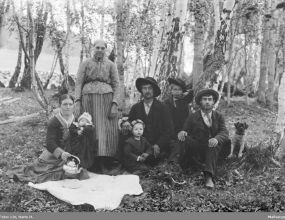 Group of Roma people in a forest, unknown location (1901). Source: Lie, Hans H. License CC BY NC 4.0.
Group of Roma people in a forest, unknown location (1901). Source: Lie, Hans H. License CC BY NC 4.0. Roma from Finland, also known as Kale, or Kaale, have a continuous history of settling in Finland. The first Roma migrants arrived in mainland Sweden in 1512, and by 1559, there were records of their presence in Finland, in the account books of the Kastelholm Castle on the Åland Islands.
Roma first settled in what was then the Kingdom of Sweden-Finland in the early sixteenth century. In the beginning, people had a favorable view of the Roma, whom they believed had migrated from southern Russia and were referred to as Tartars. However, this perception soon changed as their distinct way of life didn’t get along with societal norms. Roma's nomadic lifestyle enabled them to be engaged in traditional occupations like traveling craftsmen, but it also prevented them from integrating into the larger population.
As Roma continued to move within the Kingdom, the Government of Sweden-Finland and the Lutheran church adopted increasingly negative policy towards them. The church denied all services to Roma, including baptizing children, solemnizing marriages, not allowing burials on sacred grounds, and not providing health care. This marginalization extended to the drafting of laws aimed at expelling Roma from the kingdom. One of the harshest measures was the Hanging Law of 1637, which authorized the killing of Roma without trial unless they voluntarily left the country, and this law remained in force for a hundred years. These severe measures drove Roma even further to the margins of society.
Forced relocation and assimilation policies
By the seventeenth century, Roma were forced by the Government to relocate to the eastern part of the Realm, which now forms modern Finland. During this period, they continued to face significant discrimination and hardship. Legal measures aimed at integrating them into society often resulted in their placement in labor camps. A law enacted in 1863 further hardened attitudes towards the Roma, transferring many from labor camps to the prison in Hämeenlinna.
At the beginning of 19th century, after the Finnish War in 1809, Russia captured the region of Finland from Sweden. Finland became an autonomic part of Imperial Russia and most of the laws from the time of the Swedish rule remained in force. At the end of the eighteenth and the beginning of the nineteenth centuries, the official policy in Finland was to assimilate Roma into the Finnish population. This included separating Roma children from their parents and banning the Kale language. Despite these very harsh measures, the Roma managed to preserve their cultural identity and traditions.
In the late 19th century, the Finnish Senate frequently addressed Roma issues but made no concrete decisions to improve their living conditions. Usually, the task of integrating Roma into Finnish society was given to the clergy. The first census of the Roma population was organized by the clergy in 1863, and a more precise calculation in 1885 listed a total of 1,551 Roma, though it did not reach all Roma living in the countryside.
The 20th century
When Finland gained independence from Russian Empire in 1917, Roma, along with all other groups, gained Finnish citizenship. However, the state authorities maintained an intolerant attitude towards Roma lifestyle.
Finland had no specific policy regarding Roma people until the 1940s. After World War II, the economic and social position of Roma further weakened as their traditional trades no longer offered a viable living. Economic necessity forced Roma to gradually settle down, with the itinerant lifestyle largely ending by the 1960s. This period also marked a significant shift in societal attitudes towards the Roma. The National Board on Roma Affairs, established in 1956, took on the task of overseeing and improving the socio-economic and cultural position of Roma. Not until 1968 were multiple Roma representatives appointed to the Advisory Board on Roma Affairs as part of a reform effort. This move signalled the start of a more structured Roma policy focusing on their rights, supported by the prevailing social climate at the time.
In the 1980s, the Roma community in Finland was granted special home loans provided by state funds, leading to a significant improvement in living conditions, with only a fifth of Roma living in inadequate housing. Unfortunately, despite Government initiatives, Roma still face challenges in securing housing in the private market due to discrimination. Regarding the education, Roma have been hesitant to pursue it out of fear of assimilation. However, a shift towards a more positive attitude towards education began in the 1990s, influenced by Government support introduced in the 1980s for teaching the Romani language and culture.
In 1995, an amendment to the 1919 Constitution of Finland guaranteed the Roma, along with the Sámi and other minorities in Finland, the right to retain and develop their own language and culture. Consequently, the Kale language now has the status of a non-territorial minority language, and Roma community of Finland is recognized as a national minority under the European Framework Convention for the Protection of National Minorities.
Despite significant progress, challenges remain. Discrimination in housing and employment persists, and the Roma continue to face social exclusion. However, efforts to preserve Roma culture and language are implemented into Governmental policy. The Finnish Government, alongside various non-governmental organizations, has worked towards promoting Roma rights and ensuring their inclusion in the broader societal framework. Cultural events, educational programs, and advocacy by Roma organizations play crucial roles in maintaining their heritage.